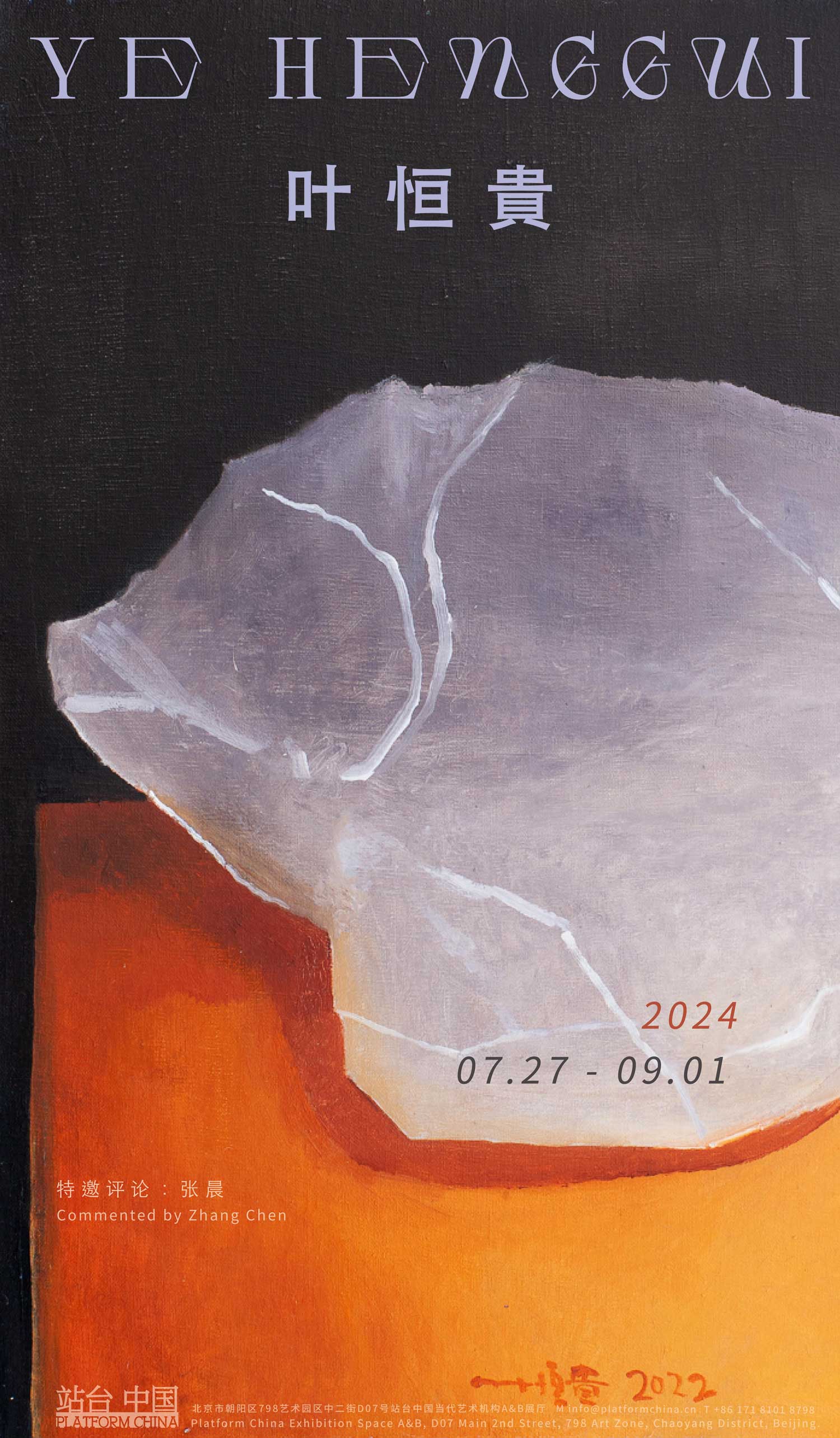展期 Period:
2024.7.27—2024.9.1
艺术家 Artist:
地点 Venue:
站台中国当代艺术机构 Platform China Contemporary Art Institute
前言 Introduction:
站台中国将于7月27日隆重呈现艺术家叶恒贵同名个展,展览将在A&B展厅饱满呈现其绘画中的活力和持久的动力。
叶恒贵,1962年安徽马鞍山生人。1989年他从中央美术学院毕业,分配至湖北武汉的华中师范大学担任教职。90年代初的叶恒贵,并没有像同届同学方力钧、刘炜那样很快地大红大紫,而是进入了一种缓慢生长的状态直至今日。有人说这是他的“慢性子”所致,他却很欣赏自己的这种状态。“声声慢”式的持续性发展恰是其内心的坚持与强大,亦是绘画中难能可贵的活力和持久的动力。2000年后,叶恒贵毅然决然地辞去了条件优越的大学教师职业,留在北京作为职业画家。他还是那样淡然和洒脱,自拒浮躁安心画画,安于边缘化的状态。
九十年代和八十年代不同,各种艺术思潮和艺术商品化裹挟在一起,让许多画家既亢奋又无所适从。身处喧嚣的年代,叶恒贵以静对动,看似孤独远离大潮,在自己的内心世界,在咫尺画室,在缤纷的现实中找到了自己面对绘画的角度。既避开了一蹴而就的高昂浪头,也同样躲闪开激荡中式微的回落。主流营造的崇高文化实际上暗藏着一个价值序列,即否定当下生活的合法性。似乎生活方式与系统的脱离与否直接导向着一种好和坏的二元判断。而叶恒贵却选择了自身最为平常的眼光,用最质朴的方式回归圆满的本性和心魄,试图捕捉日常生活中的闪烁。他画了大量的各色人物,风景,日常场景和用品,近年的作品又趋向半抽象、平面和极简,绘画语言干净纯粹,画面是那么地富有生活情调和诗意,像看蓝天大海那样清澄透彻。
叶恒贵以日常所“见”作为绘画的题材和内容。他笔下的众多 “物”,恰是其与世界的接触和驻足。正如黑格尔所说:“熟知并非真知。”最为随处可见的物、景和人事实上或许恰巧是以正当的名义被忽视最多的存在。我们或许都不会给予一处墙面的影子、一个倾空的杯子、一个只余下脖颈处皮肤的背影多一刹那的注视。它们太过于平凡,轻的似乎抛入时代的涌动中就会立刻随风而去。而叶恒贵拒绝这种对于生活的遗忘。他主动选择了这种平凡,并使之成为他在绘画中的恒久动力。生活哪有那么多惊鸿一瞥,更多则是以庸常的眼光拆解着碎屑般的时光。在他的绘画中,这些“物”没有高低贵贱、没有主次之分,平等而相互接纳。它们意味着另一种无拘无束,由不被赋予定义的日常物重新唤起艺术家自内而外的目光。它们内敛而庄重的栖息于绘画之内,清净而伫立,拒绝任何象征或者寓言,让平凡而不凡的物成为绵延的时间。
他所坚信的:“我最在意的是保持绘画的活力,以及绘画对我产生的持续动力。”在平常中所生成的内驱力既支撑着叶恒贵,这种本真的热爱也同样托举着他的绘画,绘画既是叶恒贵的生活本身,亦是他的栖息之地。
Platform China will grandly present the solo exhibition of artist Ye Henggui on July 27th, showcasing the vibrant energy and enduring momentum in his paintings at the A&B Exhibition Space.
Ye Henggui was born in Ma'anshan, Anhui in 1962. He graduated from the Central Academy of Fine Arts in 1989 and was assigned to teach at Huazhong Normal University in Wuhan, Hubei. In the early 1990s, unlike his classmates Fang Lijun and Liu Wei, who quickly rose to fame, Ye Henggui entered a state of slow growth that continues to this day. Some attribute this to his "slow pace," but he appreciates this state. The "slow and steady" development is a testament to his inner persistence and strength, as well as the precious vitality and enduring momentum in his painting. After 2000, Ye Henggui resolutely left his well-endowed university teaching position to stay in Beijing as a professional painter. He remains indifferent and carefree, refusing to be agitated and focusing on painting, content with being on the periphery.
The 1990s were different from the 1980s, with various artistic trends and the commodification of art intertwined, causing many painters to be both excited and at a loss. In the noisy era, Ye Henggui faced the dynamic with tranquility, seemingly isolated from the mainstream yet finding his own angle towards painting in his inner world, within his small studio, amidst the colorful reality. He avoided the high waves that could be achieved overnight and also dodged the decline in the turbulent middle. The lofty culture created by the mainstream actually concealed a value sequence, which negates the legitimacy of current life. It seems that the detachment or attachment to the system directly leads to a binary judgment of good and bad. However, Ye Henggui chose the most ordinary perspective for himself, returning to the perfect nature and soul in the most simple way, trying to capture the glimmer in daily life. He painted a large number of various characters, landscapes, daily scenes, and objects. His recent works have tended to be semi-abstract, flat, and minimalist. The language of painting is clean and pure, and the picture is so full of life and poetry, as clear and transparent as looking at the blue sky and the sea.
Ye Henggui takes the "seen" in everyday life as the subject and content of his paintings. The many "objects" depicted in his works are precisely his contact and pause with the world. As Hegel said, "Familiarity is not genuine knowledge." The most common objects, scenes, and people may in fact be the most overlooked existences under the guise of legitimacy. We might not spare a second glance for a shadow on a wall, an emptied cup, or a silhouette with only the skin of the neck exposed. They are too ordinary, light as if they would be instantly swept away by the currents of time. Yet, Ye Henggui refuses to forget about life in this way. He actively chooses this ordinariness and makes it a lasting force in his painting. Life doesn't have so many fleeting moments; more often, it is with a mundane gaze that we dissect the fragmented moments. In his paintings, these "objects" have no hierarchy or distinction, accepting each other equally. They represent another kind of freedom, where everyday objects not given definitions reawaken the artist's gaze from within. They reside within the paintings with restraint and solemnity, standing pure and upright, rejecting any symbolism or allegory, allowing ordinary yet extraordinary objects to stretch into enduring time.
What he firmly believes is: "What I care about most is maintaining the vitality of painting and the continuous momentum it brings to me." The internal drive generated from the ordinary not only supports Ye Henggui but also lifts his painting. Painting is not only Ye Henggui's life itself but also his place of habitation.

